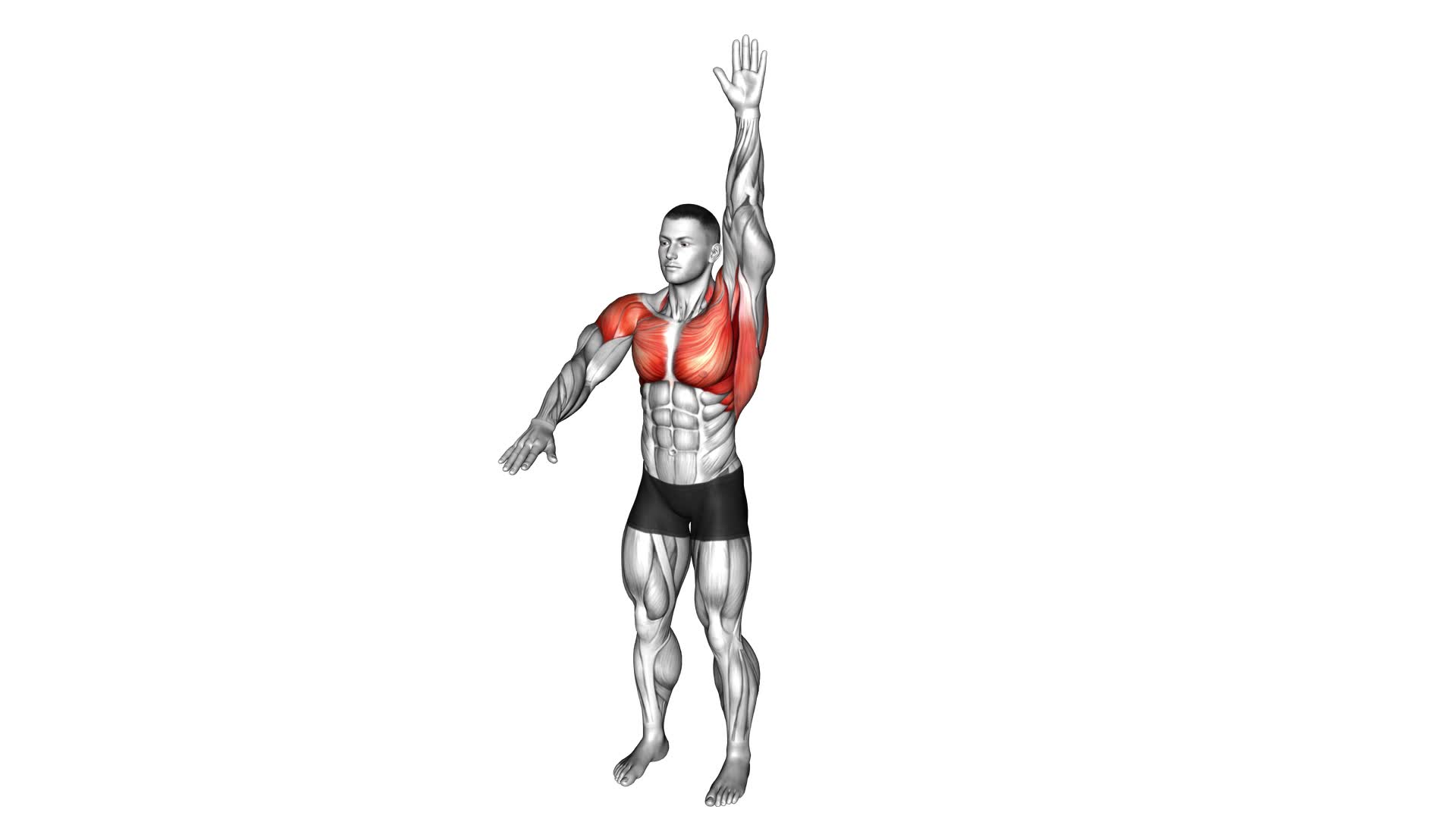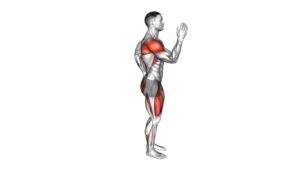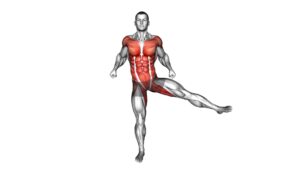Arms-up and Down – Video Exercise Guide & Tips

Get ready to tone and strengthen your arms with the arms-up and down exercise!
Watch This Exercise Video
This video exercise guide will show you the proper form and technique, as well as common mistakes to avoid.
You'll also discover variations and progressions to challenge yourself and maximize your results.
So grab your weights and get ready to feel the burn as you sculpt your arms to perfection.
Let's dive in and start working those biceps and triceps!
Key Takeaways
- Arms-up and Down exercise targets multiple muscle groups in the upper body and strengthens and tones the biceps, triceps, shoulders, and chest muscles.
- Proper form and technique for Arms-up and Down include maintaining a strong grip on the weights, standing up straight with feet shoulder-width apart, and lifting arms out to the sides and up until parallel to the ground.
- Common mistakes to avoid during Arms-up and Down include lifting shoulders instead of keeping them relaxed, excessively bending the elbows, and arching the back instead of engaging core muscles.
- Variations and progressions for Arms-up and Down include trying single-arm arms-up and down, adding resistance with dumbbells or resistance bands, and increasing the number of repetitions or duration of each set.
Benefits of Arms-up and Down Exercise
You will experience numerous benefits when incorporating the arms-up and down exercise into your workout routine. This exercise is a great way to engage your upper body and reap the benefits of weightlifting.
One of the main benefits of the arms-up and down exercise is that it targets multiple muscle groups in your upper body. By lifting weights in an upward and downward motion, you engage your biceps, triceps, shoulders, and chest muscles. This exercise helps to strengthen and tone these muscles, leading to improved upper body strength and definition.
In addition to building strength, the arms-up and down exercise also helps to improve your overall posture. As you lift the weights, you naturally engage your core muscles to stabilize your body. This helps to strengthen your back muscles, improving your posture and reducing the risk of developing back pain.
Furthermore, the arms-up and down exercise is a versatile exercise that can be easily modified to suit your fitness level. Whether you're a beginner or an experienced weightlifter, you can adjust the weight and repetitions to challenge yourself and continue to make progress.
Incorporating the arms-up and down exercise into your workout routine is a great way to reap the benefits of weightlifting while targeting your upper body muscles. By strengthening your upper body and improving your posture, you won't only look better but also feel stronger and more confident in your daily activities.
Proper Form and Technique for Arms-up and Down
To perform the arms-up and down exercise with proper form and technique, it's important to:
- Maintain a strong grip on the weights throughout the entire range of motion. This will help to engage the muscles in your arms, shoulders, and upper back effectively.
- Start by standing up straight with your feet shoulder-width apart and your knees slightly bent.
- Hold a dumbbell in each hand, palms facing forward.
- Slowly lift your arms out to the sides and up until they're parallel to the ground, keeping your elbows slightly bent.
- Then, lower your arms back down to the starting position in a controlled manner.
- Remember to keep your core engaged and your back straight throughout the exercise.
To ensure proper form, avoid common errors such as:
- Swinging your arms or using momentum to lift the weights.
- Focus on using your muscles to lift and lower the weights, rather than relying on momentum.
- Additionally, if you find this exercise too challenging, you can modify it by using lighter weights or performing the movement without weights initially.
By maintaining a strong grip and following these proper form and technique guidelines, you can maximize the effectiveness of the arms-up and down exercise.
Now, let's move on to discussing the common mistakes to avoid during this exercise.
Common Mistakes to Avoid During Arms-up and Down
To avoid compromising the effectiveness of your arms-up and down exercise, it's important to be aware of common mistakes that you should steer clear of. Here are some common mistakes to avoid and tips for maintaining proper technique:
- Lifting your shoulders: One common mistake is lifting your shoulders while performing the arms-up and down exercise. This can put unnecessary strain on your neck and upper back. Instead, focus on keeping your shoulders relaxed and down throughout the movement.
- Bending your elbows too much: Another common mistake is bending your elbows excessively during the exercise. This can limit the range of motion and reduce the effectiveness of the exercise. Make sure to keep a slight bend in your elbows, but avoid excessive bending.
- Arching your back: Arching your back is a common mistake that can lead to lower back discomfort. To maintain proper form, engage your core muscles and keep your spine in a neutral position throughout the exercise.
- Raising your arms too high: While it may be tempting to lift your arms as high as possible, it's important to avoid overextending your range of motion. Lift your arms to shoulder level and avoid straining or reaching beyond your comfort zone.
Variations and Progressions for Arms-up and Down
There are several ways to vary and progress the arms-up and down exercise. By incorporating different variations and modifications, you can challenge your muscles in new ways and continue to make progress in your fitness journey.
One variation you can try is the single-arm arms-up and down. Instead of using both arms simultaneously, you can perform the exercise with one arm at a time. This variation not only increases the difficulty but also allows for a greater range of motion and engagement of the core muscles.
Another modification is to add resistance. You can do this by using dumbbells or resistance bands while performing the arms-up and down exercise. The added resistance helps to further strengthen and tone your muscles.
To progress the arms-up and down exercise, you can increase the number of repetitions or the duration of each set. You can also increase the speed at which you perform the exercise, challenging your muscles to work harder and adapt to the increased demand.
Remember to listen to your body and progress at your own pace. It's important to maintain proper form and technique throughout the exercise to avoid injury.
Incorporating these variations and modifications into your arms-up and down routine will keep your workouts interesting and help you achieve your fitness goals.
Tips for Maximizing Results With Arms-Up and Down
To maximize your results with the arms-up and down exercise, focus on maintaining proper form and technique throughout each repetition. Here are some tips to help you get the most out of this exercise:
- Keep your core engaged: By activating your core muscles, you can maximize the intensity of the exercise. Imagine pulling your belly button towards your spine and maintaining a strong and stable midsection throughout the movement.
- Control your breathing: Proper breathing techniques can enhance your performance and help you maximize the benefits of the exercise. Inhale as you raise your arms up and exhale as you lower them down. This won't only provide oxygen to your muscles but also help you maintain a steady rhythm.
- Use a full range of motion: When performing the arms-up and down exercise, make sure to fully extend your arms overhead and lower them down to your sides. By utilizing the full range of motion, you can target and engage more muscles, resulting in greater overall effectiveness.
- Gradually increase the resistance: As you become more comfortable with the exercise, consider using weights or resistance bands to further challenge your muscles. Gradually increase the resistance over time to maximize your progress and continue challenging yourself.
Frequently Asked Questions
How Many Repetitions Should I Do for the Arms-Up and Down Exercise?
To determine the number of repetitions for the arms-up and down exercise, you should consider factors like your fitness level and goals.
It's generally recommended to start with lighter weights and perform 8-12 repetitions per set. As you become stronger and more comfortable, you can increase the number of repetitions or add more weight.
Remember to listen to your body and adjust accordingly. Consulting with a fitness professional can also provide personalized guidance.
Can I Use Weights or Resistance Bands While Performing the Arms-Up and Down Exercise?
Yes, you can definitely use weights or resistance bands while performing the arms-up and down exercise. Incorporating weights or resistance bands can provide additional resistance and challenge your muscles even more.
This can help increase muscle strength and tone in your arms, shoulders, and upper back. Using weights or resistance bands can also help improve your overall body strength and enhance the effectiveness of the exercise.
Should I Perform the Arms-Up and Down Exercise Before or After My Cardio Workout?
Before or after your cardio workout, you should perform the arms-up and down exercise to maximize its benefits. This exercise targets your shoulder muscles and improves upper body strength. By incorporating weights or resistance bands, you can increase the intensity and challenge your muscles even more.
Additionally, there are variations of the arms-up and down exercise that you can try to add variety to your workout routine and target different muscle groups.
Can the Arms-Up and Down Exercise Help With Improving Posture?
The arms-up and down exercise can definitely help improve your posture. By engaging the muscles in your shoulders, back, and arms, this exercise promotes better alignment and strengthens the upper body.
It also helps to improve overall strength, adding stability and balance to your body. To get the most out of this exercise, focus on maintaining proper form and alignment. Keep your core engaged, shoulders relaxed, and arms straight throughout the movement.
Are There Any Modifications or Adaptations for Individuals With Shoulder or Wrist Injuries?
When dealing with shoulder or wrist injuries, it's important to make modifications to the arms-up and down exercise.
For those with shoulder injuries, you can try using lighter weights or resistance bands to reduce strain.
Individuals with wrist injuries can modify the exercise by using wrist wraps or performing the movement without weights.
Additionally, if you have limited range of motion, you can start with smaller arm movements and gradually increase as you build strength and flexibility.
Conclusion
In conclusion, the arms-up and down exercise is a simple yet effective way to improve upper body strength and flexibility. By performing this exercise with proper form and avoiding common mistakes, you can maximize your results and prevent injury.
Additionally, incorporating variations and progressions into your routine can add variety and challenge to your workout. Remember to always listen to your body and adjust the exercise as needed.
Keep up the good work and enjoy the benefits of the arms-up and down exercise!

Author
Years ago, the spark of my life’s passion ignited in my mind the moment I stepped into the local gym for the first time. The inaugural bead of perspiration, the initial endeavor, the very first surge of endorphins, and a sense of pride that washed over me post-workout marked the beginning of my deep-seated interest in strength sports, fitness, and sports nutrition. This very curiosity blossomed rapidly into a profound fascination, propelling me to earn a Master’s degree in Physical Education from the Academy of Physical Education in Krakow, followed by a Sports Manager diploma from the Jagiellonian University. My journey of growth led me to gain more specialized qualifications, such as being a certified personal trainer with a focus on sports dietetics, a lifeguard, and an instructor for wellness and corrective gymnastics. Theoretical knowledge paired seamlessly with practical experience, reinforcing my belief that the transformation of individuals under my guidance was also a reflection of my personal growth. This belief holds true even today. Each day, I strive to push the boundaries and explore new realms. These realms gently elevate me to greater heights. The unique combination of passion for my field and the continuous quest for growth fuels my drive to break new ground.



